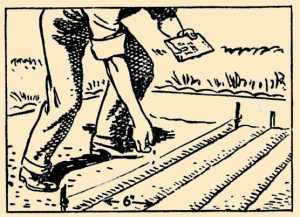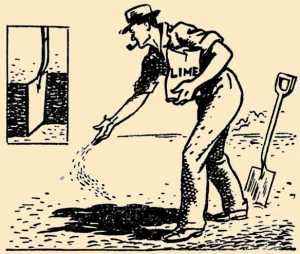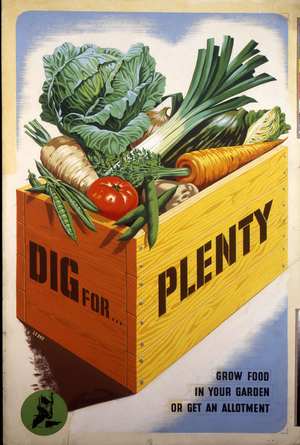Pick herbs now—just before they flower. Gather shoots of thyme, sage, mint, marjoram, tarragon and parsley. Tie them in bundles, wash them, cover with muslin to keep out dust and hang to dry in an airy shed or near the fire. When thoroughly dry and crisp, crush to a mealy texture and store in lidded jars or bottles away from the light.
Your last chance TAKE STOCK
Now is the time to make sure of winter’s greenstuff—to make good losses caused by pests or diseases—opportunity to sit down after that back-aching weeding—just sit and think—sit and make sure—it’s your last chance.
If you have not yet sown spring cabbage, do so at once or it will soon be too late. Do not sow in that part of the seedbed where spring sowings of cabbage were made this year. The soil may contain Cabbage Root Fly or the spores of Club Root. Sow seed thinly 1 in. deep in drills made 6 in. apart; sow enough to plant four rows of spring cabbage on the ground which will be left free after the onions are harvested.
 Do not sow too many, but allow a small reserve for making good any losses after planting out in September. If possible, sow after rain; or if the soil is very dry, water the seedbed a few hours before sowing. Where space is confined, sow “Harbinger”, which is compact and hearty. Where more room is available “Early Offenham” and “Durham Early” are good varieties.
Do not sow too many, but allow a small reserve for making good any losses after planting out in September. If possible, sow after rain; or if the soil is very dry, water the seedbed a few hours before sowing. Where space is confined, sow “Harbinger”, which is compact and hearty. Where more room is available “Early Offenham” and “Durham Early” are good varieties.
Sow late kale now where it is to mature, and thin as required during growth—it will give you a late green crop in March and April. Sow winter radish—they can be lifted and stored. Smooth-leaved Batavian endive, sown now and treated as lettuce, will last well into the winter, if it is blanched by tying up loosely with raffia and protected by a pot or box.
All the cabbage varieties mentioned are still widely available and Batavian endive can be found with a little searching
Current practice is to sow cabbage seed just ½ in. deep rather than the inch recommended in the guide. The same applies to Lettuce seed.
The main thing is to make sure of winter greens. Sow now for the lean months. If you are following the Ministry’s Cropping Plan, make yourself completely comfortable in a deck chair—and study it. If you have any gaps or corners to spare, fill them with winter greens.
Prepare for AUTUMN SOWINGS
 Ground for winter lettuce and turnips should be prepared a week or two in advance. Avoid ground likely to become damp in the winter ; lettuces can stand up to cold much better than to wet conditions.
Ground for winter lettuce and turnips should be prepared a week or two in advance. Avoid ground likely to become damp in the winter ; lettuces can stand up to cold much better than to wet conditions.
Dig the ground over one spade’s depth and leave it for a week or more to settle. If the soil is poor, rake in a dressing of 1-1½ oz. per square yard of National Growmore fertiliser. If the ground was not limed in the spring, dress with lime and fork in lightly immediately after digging, but do not apply at the same time as the fertiliser. Leave the ground alone until the lime is well washed in and then—just before sowing—apply the fertiliser and fork it in lightly.
For lettuce, tread the ground firmly and evenly and rake it down finely. Choose a variety suitable for winter and sow seed thinly in drills ¾ in. deep and 1 ft. apart. When seedlings are large enough to be handled in late September and early October, they will be thinned out to 9 in. apart.


